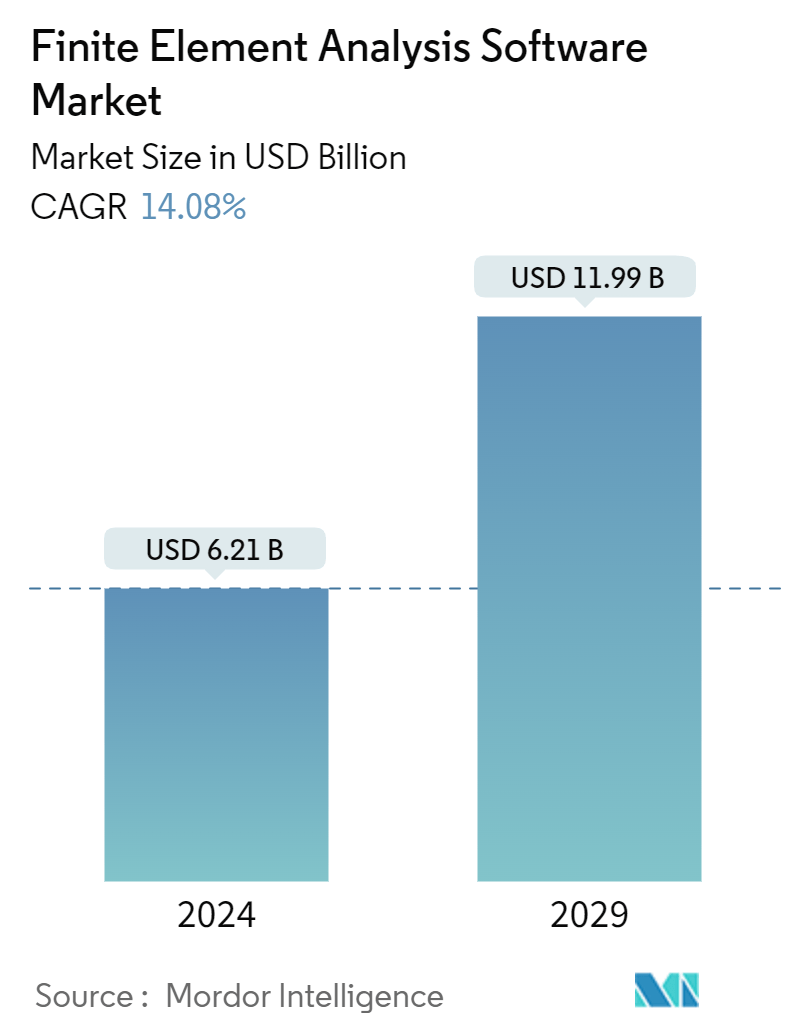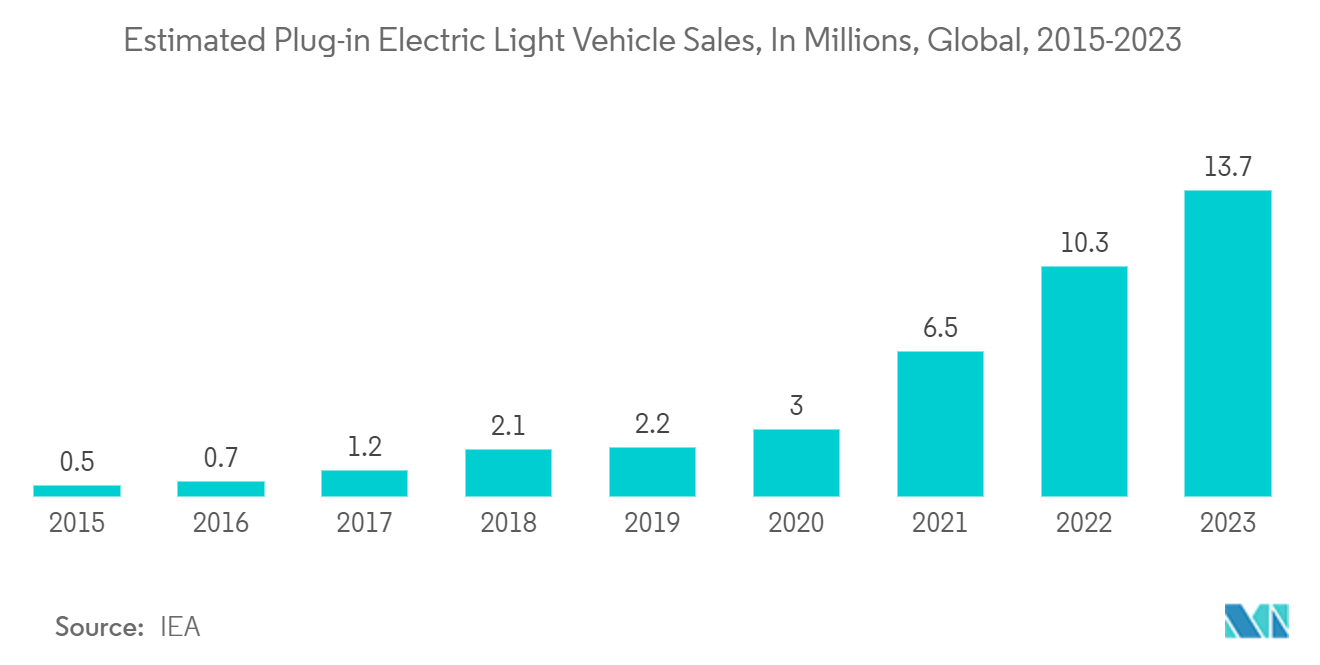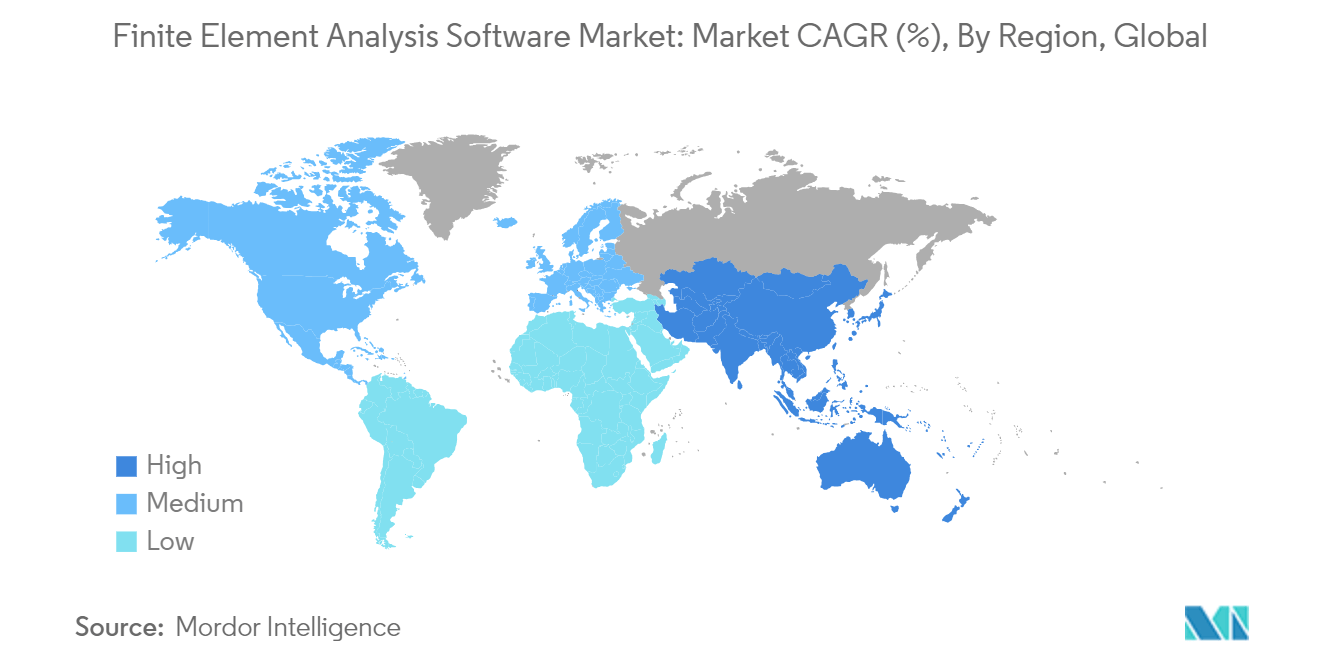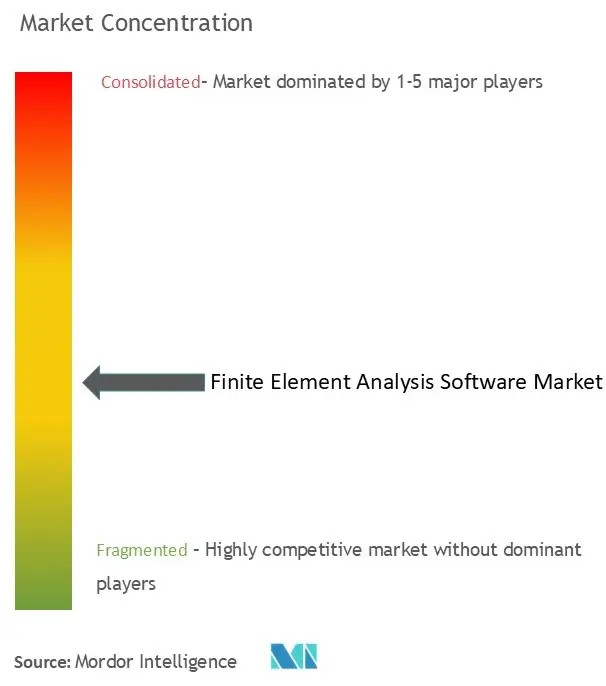Finite Element Analysis Software Market Size

| Study Period | 2022 - 2029 |
| Market Size (2024) | USD 6.21 Billion |
| Market Size (2029) | USD 11.99 Billion |
| CAGR (2024 - 2029) | 14.08 % |
| Fastest Growing Market | Asia Pacific |
| Largest Market | North America |
Major Players
*Disclaimer: Major Players sorted in no particular order |
Finite Element Analysis Software Market Analysis
The Finite Element Analysis Software Market size is estimated at USD 6.21 billion in 2024, and is expected to reach USD 11.99 billion by 2029, growing at a CAGR of 14.08% during the forecast period (2024-2029).
- The global finite element analysis software market growth is governed by the increasing adoption of virtual prototyping, the rising demand for safety and comfort in modern automobiles, coupled with the growing need to create higher-quality products in a reduced design cycle, minimizing material and time waste. This trend is further fueled by a rising demand for lightweight, energy-efficient designs and the escalating complexity of product designs.
- As governments worldwide tighten regulatory standards, the demand for simulation techniques to ensure safety and reliability has seen a notable uptick, indicating a positive market outlook.
- Technological advancements in the FEA software landscape, such as the shift toward cloud-based solutions, are further augmenting the adoption of FEA software across industries worldwide. Businesses across diverse sectors are increasingly making substantial shifts in their approach to product development and innovation, further propelling market growth. This heightened adoption underscores the pivotal role of FEA software in boosting precision and simultaneously reducing the time and costs associated with physical prototypes.
- The rising demand and production of electric and hybrid vehicles, coupled with an increase in fuel production and consumption, drives the growth of the global finite element analysis software market. Electric and hybrid vehicles (EHVs) are lauded for their environmental benefits and fuel efficiency.
- However, they also introduce vehicle design and performance challenges, such as the vibration and noise generated by the electric motor, battery, and powertrain. Such disturbances can compromise the vehicle's comfort, safety, and the longevity of its components. In response, the demand for FEA software to simulate and refine the dynamic behavior of both the vehicle and its parts is growing, driving the growth of the market.
- The intricate nature of FEA software necessitates recruiting highly skilled professionals capable of conducting advanced analyses. Such recruitment demands a considerable investment of time and financial resources, potentially dissuading companies from embracing FEA solutions. This challenge is pronounced for smaller firms with limited budgets and countries lacking a robust pool of FEA-trained engineers.
- Geopolitical risks from elections, polarization, and conflicts within and between states significantly impact both global and national economies. The ongoing geopolitical concerns worldwide, notably the Russia-Ukraine War and Middle-East crisis, have a lasting impact on the global finite element analysis software market.
Finite Element Analysis Software Market Trends
Automotive Application Segment Holds Significant Market Share
- The surge in the automotive sector is likely to boost the growth of the market studied. For instance, according to the China Passenger Car Association, annual sales of new energy passenger vehicles in China are projected to rise from 3.69 million units in 2021 to 7.8 million units by 2028. The German Association of the Automotive Industry (VDA) highlights that Germany boasts one of the world's largest automobile industries. In 2022, Germany's passenger car sales reached approximately 2.65 million units, marking a modest increase from 2.62 million units in 2021. Such growth in sales drives the adoption of fine element analysis software.
- Safety remains a top priority in automotive engineering, with stringent regulations imposed by regulatory bodies worldwide. According to the report published by WHO in December 2023, approximately 1.19 million people die each year because of road traffic crashes. Road traffic crashes cost most countries 3% of their gross domestic product.
- Hence, to prevent such road accidents, automotive companies use FEA software, which plays a crucial role in ensuring that vehicles meet these safety standards. By simulating crash tests, impact forces, and other safety-related scenarios, FEA enables engineers to evaluate and enhance the structural integrity of vehicle components. This virtual testing helps identify potential weaknesses and optimize designs to improve crashworthiness and passenger protection.
- Several government initiatives towards sustainable mobility coupled with growing investments in e-mobility startups will drive the demand and production of electric vehicles, supporting the growth of the global finite element analysis software market over the forecast period. For instance, the International Energy Association (IEA) estimated that 2023 saw plug-in electric light vehicle (PEV) sales of around 13.7 million units.
- In conclusion, the rising demand for finite element analysis software in the automotive sector reflects its growing importance in addressing the challenges of modern vehicle design and development. FEA software provides valuable insights that enhance safety, optimize performance, and accelerate product development while reducing costs. As the automotive industry continues to evolve and embrace new technologies, the role of FEA in driving innovation and efficiency will become even more crucial.

North America is Expected to Hold Significant Market Share
- The US finite element analysis (FEA) software market is witnessing robust growth fueled by technological advancements and heightened demand across diverse industries. FEA software plays a crucial role in simulating and analyzing intricate engineering challenges, facilitating the optimization of designs and processes.
- There is a growing trend toward the adoption of cloud-based FEA solutions, which provide scalability, flexibility, and cost-effectiveness. With cloud FEA software, users can conduct high-computation simulations without investing in costly on-premises hardware, broadening accessibility to a wider array of companies, including small and medium-sized enterprises (SMEs).
- For instance, in November 2023, Ansys, in partnership with TSMC and Microsoft, validated a solution aimed at analyzing mechanical stresses in multi-die 3D-IC systems. These systems are produced using TSMC's advanced packaging technologies, known as 3DFabric. This joint solution enhances customer confidence in tackling new multiphysics challenges, thereby bolstering the functional reliability of designs leveraging TSMC's 3DFabric suite. Ansys Mechanical, the premier finite element analysis software, adeptly simulates mechanical stresses in 3D-ICs, particularly those induced by thermal gradients. Furthermore, this solution has demonstrated its efficiency on Microsoft Azure, ensuring swift turn-around times for intricate 2.5D/3D-IC systems.
- Integrating artificial intelligence (AI) and machine learning (ML) with finite element analysis (FEA) software significantly boosts its efficiency in managing intricate simulations. These advancements enable automated mesh generation, optimization, and predictive analytics, rendering FEA software both robust and user-friendly.
- In Canada, the market for finite element analysis (FEA) software is witnessing consistent growth, fueled by the rising embrace of sophisticated engineering solutions across diverse sectors. FEA software is pivotal in product and system design, simulation, and analysis, empowering engineers to enhance performance, cut costs, and bolster safety.
- Canada's energy sector, encompassing both oil and gas and renewable energy, utilizes FEA software to design and analyze intricate structures, including pipelines, wind turbines, and offshore platforms. The push for efficient and safe energy production and distribution systems drives the growing adoption of FEA solutions. Canada is making significant investments in its oil and gas infrastructure. A prime example is The Canadian Prosperity Project, currently in the announced stage, which is set to commence operations in 2030, with an estimated cost of CAD 24 billion (approximately USD 17.78 billion). This project will oversee the operation of the 4,500 km-long Canadian Prosperity Pipeline.

Finite Element Analysis Software Industry Overview
The Finite Element Analysis Software Market is semi-fragmented with the presence of major players like Ansys Inc., Autodesk Inc., Bentley Systems Inc., Altair Engineering Inc., and Synopsys, Inc. Market players are adopting strategies, including partnerships and acquisitions, to enhance their product offerings and gain sustainable competitive advantage.
• March 2024 - Dassault Systèmes and Embraer declared that Dassault Systèmes' simulation technology played a pivotal role in virtually simulating, analyzing, and testing Eve Air Mobility's electric vertical take-off and landing (eVTOL) aircraft.
Finite Element Analysis Software Market Leaders
-
Ansys Inc.
-
Autodesk Inc.
-
Bentley Systems Inc.
-
Altair Engineering Inc.
-
Synopsys, Inc.
*Disclaimer: Major Players sorted in no particular order

Finite Element Analysis Software Market News
- July 2024 - Altair partnered with HP Inc. to provide Altair with proprietary material information that will bolster the Altair Material Data Center, which enables designers, engineers, and scientists to search and compare materials in a standalone application or by the interface of simulation and optimization tools. Moreover, engineers with access to the Material Data Center will be able to use HP material data to design efficient parts, conduct structural analysis using FEA, and predict and fix manufacturing defects during design and simulation.
- February 2024 - Cadence Design Systems launched Celsius Studio, a comprehensive AI thermal design and analysis solution for electronic systems. Celsius Studio offers benefits, including True System-Level Thermal Analyses. It combines the finite element method (FEM) with computational fluid dynamics (CFD) to provide full-system thermal analysis from the chip and package to the board and the entire end-system.
Finite Element Analysis Software Market Report - Table of Contents
1. INTRODUCTION
- 1.1 Study Assumptions and Market Definition
- 1.2 Scope of the Study
2. RESEARCH METHODOLOGY
3. EXECUTIVE SUMMARY
4. MARKET INSIGHTS
- 4.1 Market Overview
- 4.2 Technology Snapshot
- 4.3 Industry Value Chain Analysis
-
4.4 Industry Attractiveness - Porter's Five Forces Analysis
- 4.4.1 Bargaining Power of Suppliers
- 4.4.2 Bargaining Power of Buyers
- 4.4.3 Threat of Substitute Products and Services
- 4.4.4 Degree of Competition
- 4.4.5 Threat of New Entrants
5. MARKET DYNAMICS
-
5.1 Market Drivers
- 5.1.1 Rising Demand and Production of Electric and Hybrid Vehicles
- 5.1.2 Increase in Fuel Production and Consumption
-
5.2 Market Restraints
- 5.2.1 Complex and Time Consuming Process
6. MARKET SEGMENTATION
-
6.1 By Deployment
- 6.1.1 On-Premise
- 6.1.2 Cloud
-
6.2 By Organization Size
- 6.2.1 Small and Medium Enterprises (SMEs)
- 6.2.2 Large Enterprises
-
6.3 By Application
- 6.3.1 Construction
- 6.3.2 Electrical and Electronic Manufacturing
- 6.3.3 Aerospace and Defense
- 6.3.4 Oil, Gas, and Energy
- 6.3.5 Architecture and Planning
- 6.3.6 Technology Hardware and Software
- 6.3.7 Automotive
- 6.3.8 Other Applications
-
6.4 By Geography***
- 6.4.1 North America
- 6.4.1.1 United States
- 6.4.1.2 Canada
- 6.4.2 Europe
- 6.4.2.1 Nordics
- 6.4.2.2 Germany
- 6.4.2.3 United Kingdom
- 6.4.2.4 France
- 6.4.2.5 Rest of Europe
- 6.4.3 Asia
- 6.4.4 Australia and New Zealand
- 6.4.5 Latin America
- 6.4.6 Middle East and Africa
7. COMPETITIVE LANDSCAPE
-
7.1 Company Profiles*
- 7.1.1 Ansys Inc.
- 7.1.2 Autodesk Inc.
- 7.1.3 Bentley Systems Inc.
- 7.1.4 Altair Engineering Inc.
- 7.1.5 Synopsys, Inc.
- 7.1.6 Siemens AG
- 7.1.7 PTC Inc.
- 7.1.8 Dassault Systèmes
- 7.1.9 ESI Group (Keysight Technologies Inc.)
- 7.1.10 Dlubal Software GmbH
8. INVESTMENT ANALYSIS
9. MARKET OPPORTUNITIES AND FUTURE TRENDS
** Subject To AvailablityFinite Element Analysis Software Industry Segmentation
Finite element analysis (FEA) is referred to as a computerized method to predict how a product reacts to real-world forces, vibration, heat, fluid flow, and other physical effects. It shows whether a product will break, wear out, or work as expected and designed. FEA simulation is used to predict what will happen in the product development process when the product is used in its real-world application. This is aimed to ensure that it achieves whatever tasks that component needs to perform safely and efficiently.
The Finite Element Analysis software market is segmented by deployment (on-premise and cloud), by enterprise size (small and medium enterprises (SMEs) and large enterprises), by application (construction, electrical and electronic manufacturing, aerospace and defense, oil, gas, and energy, architecture and planning, technology hardware and software, automotive, other applications), and by geography (North America (United States, Canada), Europe (Nordics, Germany, United Kingdom, France, and the rest of Europe), Asia Pacific, and the rest of the World). The report provides market forecasts and size in value (USD) for all the above segments.
| By Deployment | On-Premise | |
| Cloud | ||
| By Organization Size | Small and Medium Enterprises (SMEs) | |
| Large Enterprises | ||
| By Application | Construction | |
| Electrical and Electronic Manufacturing | ||
| Aerospace and Defense | ||
| Oil, Gas, and Energy | ||
| Architecture and Planning | ||
| Technology Hardware and Software | ||
| Automotive | ||
| Other Applications | ||
| By Geography*** | North America | United States |
| Canada | ||
| By Geography*** | Europe | Nordics |
| Germany | ||
| United Kingdom | ||
| France | ||
| Rest of Europe | ||
| By Geography*** | Asia | |
| Australia and New Zealand | ||
| Latin America | ||
| Middle East and Africa |
Finite Element Analysis Software Market Research FAQs
How big is the Finite Element Analysis Software Market?
The Finite Element Analysis Software Market size is expected to reach USD 6.21 billion in 2024 and grow at a CAGR of 14.08% to reach USD 11.99 billion by 2029.
What is the current Finite Element Analysis Software Market size?
In 2024, the Finite Element Analysis Software Market size is expected to reach USD 6.21 billion.
Who are the key players in Finite Element Analysis Software Market?
Ansys Inc., Autodesk Inc., Bentley Systems Inc., Altair Engineering Inc. and Synopsys, Inc. are the major companies operating in the Finite Element Analysis Software Market.
Which is the fastest growing region in Finite Element Analysis Software Market?
Asia Pacific is estimated to grow at the highest CAGR over the forecast period (2024-2029).
Which region has the biggest share in Finite Element Analysis Software Market?
In 2024, the North America accounts for the largest market share in Finite Element Analysis Software Market.
What years does this Finite Element Analysis Software Market cover, and what was the market size in 2023?
In 2023, the Finite Element Analysis Software Market size was estimated at USD 5.34 billion. The report covers the Finite Element Analysis Software Market historical market size for years: 2022 and 2023. The report also forecasts the Finite Element Analysis Software Market size for years: 2024, 2025, 2026, 2027, 2028 and 2029.
Finite Element Analysis Software Industry Report
Statistics for the 2024 Finite Element Analysis Software market share, size and revenue growth rate, created by Mordor Intelligence™ Industry Reports. Finite Element Analysis Software analysis includes a market forecast outlook for 2024 to 2029 and historical overview. Get a sample of this industry analysis as a free report PDF download.



